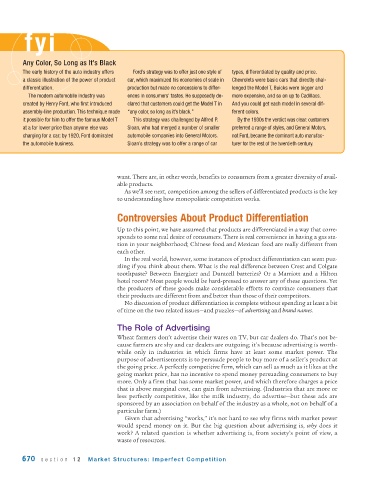Page 712 - Krugmans Economics for AP Text Book_Neat
P. 712
fyi
Any Color, So Long as It’s Black
The early history of the auto industry offers Ford’s strategy was to offer just one style of types, differentiated by quality and price.
a classic illustration of the power of product car, which maximized his economies of scale in Chevrolets were basic cars that directly chal-
differentiation. production but made no concessions to differ- lenged the Model T, Buicks were bigger and
The modern automobile industry was ences in consumers’ tastes. He supposedly de- more expensive, and so on up to Cadillacs.
created by Henry Ford, who first introduced clared that customers could get the Model T in And you could get each model in several dif-
assembly-line production. This technique made “any color, so long as it’s black.” ferent colors.
it possible for him to offer the famous Model T This strategy was challenged by Alfred P. By the 1930s the verdict was clear: customers
at a far lower price than anyone else was Sloan, who had merged a number of smaller preferred a range of styles, and General Motors,
charging for a car; by 1920, Ford dominated automobile companies into General Motors. not Ford, became the dominant auto manufac-
the automobile business. Sloan’s strategy was to offer a range of car turer for the rest of the twentieth century.
want. There are, in other words, benefits to consumers from a greater diversity of avail-
able products.
As we’ll see next, competition among the sellers of differentiated products is the key
to understanding how monopolistic competition works.
Controversies About Product Differentiation
Up to this point, we have assumed that products are differentiated in a way that corre-
sponds to some real desire of consumers. There is real convenience in having a gas sta-
tion in your neighborhood; Chinese food and Mexican food are really different from
each other.
In the real world, however, some instances of product differentiation can seem puz-
zling if you think about them. What is the real difference between Crest and Colgate
toothpaste? Between Energizer and Duracell batteries? Or a Marriott and a Hilton
hotel room? Most people would be hard-pressed to answer any of these questions. Yet
the producers of these goods make considerable efforts to convince consumers that
their products are different from and better than those of their competitors.
No discussion of product differentiation is complete without spending at least a bit
of time on the two related issues—and puzzles—of advertising and brand names.
The Role of Advertising
Wheat farmers don’t advertise their wares on TV, but car dealers do. That’s not be-
cause farmers are shy and car dealers are outgoing; it’s because advertising is worth-
while only in industries in which firms have at least some market power. The
purpose of advertisements is to persuade people to buy more of a seller’s product at
the going price. A perfectly competitive firm, which can sell as much as it likes at the
going market price, has no incentive to spend money persuading consumers to buy
more. Only a firm that has some market power, and which therefore charges a price
that is above marginal cost, can gain from advertising. (Industries that are more or
less perfectly competitive, like the milk industry, do advertise—but these ads are
sponsored by an association on behalf of the industry as a whole, not on behalf of a
particular farm.)
Given that advertising “works,” it’s not hard to see why firms with market power
would spend money on it. But the big question about advertising is, why does it
work? A related question is whether advertising is, from society’s point of view, a
waste of resources.
670 section 12 Market Structures: Imperfect Competition

